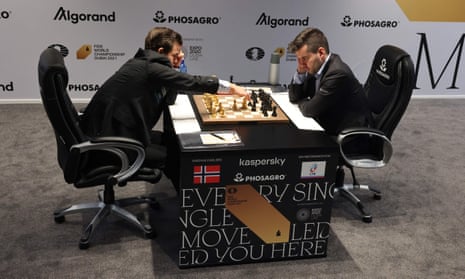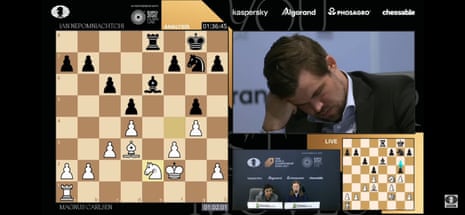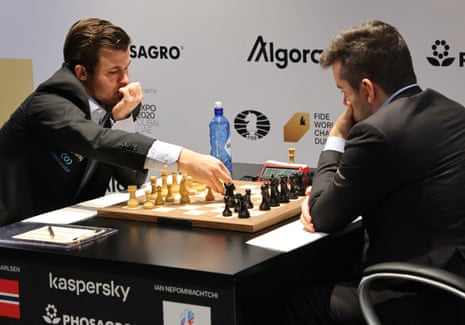That’s all for Wednesday’s coverage. Thanks for following along and be sure to check out our full report off Game 10 here.
Magnus Carlsen and Ian Nepomniachtchi draw World Chess Championship Game 10 – as it happened
- Carlsen and Nepo play to 41-move draw in 2hr 5min
- Norwegian leads 6½-3½ in best-of-14 title showdown
Wed 8 Dec 2021 10.37 EST
First published on Wed 8 Dec 2021 06.30 EST
Live feed
“Frankly I hadn’t thought about him playing the Petrov today at all,” Carlsen says. “I was preparing for various sharp openings that he could play. The thought was if he goes 1. e5, I’ll see. I didn’t think making a draw against the Petrov would be a major issue.”
Asked about the most interesting moment of today’s match, the champion says: “There wasn’t that much to talk about. I was fairly happy with the move [17. g3]. I kind thought I might be getting a very slight edge at that point. And then probably I needed to be a little more patient later on since I was kind of hoping that after allowing this [23. ... g5] to happen that I could provoke f5-f4 maybe later on, then start pushing with h4. But it all holds very well together for black there, so there is nothing. I think if I played a little more patiently there I could have had the tiniest of edges, but naturally I would have hunted for it more diligently if the match situation had been different.”
“At this point, there’s so few games to go that any draw is an excellent result,” Carlsen says. Asked about his choice to play 4. Nd3 instead of Nf3, the champion underscores his willingness to play for a half-point as black: “(It was) mainly the prospect of getting the queens off very soon and getting a drawish position.”
On whether that will govern his strategy in the remaining games, Carlsen says: “I mean I very much assume he’s going to try and win, especially with the white pieces. But sure, any half-point that I can get is great and I think that’s pretty obvious.”
Nepomniachtchi is asked about his choice to play another Petrov to open the post-game presser. “The problem playing as black is you don’t have such a good choice,” he says. “Especially in classical, even if you play a so-called sharp opening like Sicilian, if white wants to shut it down white surely will shut it down. It’s not realistic. I have a couple of tries with the white pieces in the remaining four games. Of course it depends on what I produce in the 11th game. But today it was just an idea to play a normal game, try not to blunder something in my moves.”
The moderator, American grandmaster Maurice Ashley, then follows with a bit of a howler: “You’ve only got four games left and a three-point deficit. Your strategy is still heavily trying to win this match?”
Nepomniachtchi, who’s handled these circus-like pressers well, is clearly peeved and pauses a beat before responding: “Well, that’s an absurd question.”
Carlsen says he was surprised by Nepomniachtchi’s decision to play the Petrov Defence. “I didn’t particularly think he would do that,” the champion says immediately after exiting the playing studio. “But I guess he was in damage-limitation mode at this point.”
He’s asked about Nepomniachtchi’s 7. ... Nc6, the first new move of the match and one which Carlsen spent nearly 20 minutes pondering before responding with 8. c3.
“It was a bit surprising because I thought this move order was not supposed to be that good, but I guess you have to play Bb3 in order to try and do something against it and I was not in the mood for that. I guess it was all right. After c3, it’s really pretty boring.”
Asked if it’s accurate to say both players were OK with a draw in today’s game, Carlsen agrees but adds he felt he enjoyed a small advantage early on: “Sure, but I was certainly a little bit better at some point. But maybe I was a bit rash in playing (20. g4) and (21. Bf4) and maybe I needed to put the bishop on h6 or something and be a little more patient, because I thought I had a really tiny edge at that point.”
Game 10 is a 41-move draw!
The rooks come off after 39. Rf7 Rf6+ 40. Rxf6+ Nxf6 41. Ke3. And the players shake hands and agree to a draw after 2hr 5min, the shortest game of the match so far.
And Game 10 of #CarlsonNepo is a draw after 2hr 5min, the shortest game of the match so far. pic.twitter.com/yxpyj4epCS
— Bryan Armen Graham (@BryanAGraham) December 8, 2021
Speeding toward a peaceul result after 33. Rh3 Kxg5 34. Rg3+ Kf6 35. Rf3+ Ke7 36. Nf4 Kd6 37. Ng6 Re6 38. Ne5 Ne8. Nepomniachtchi must be precise, however.
More material comes off the board in a flurry of moves: 27. ... fxg4 28. hxg4 Bxg4 29. Rxh6 Bf5 30. Bxf5 Nxf5 31. Rh7+ Ng7 32. fxg5 Kg6. First a pair of pawns, then the light-squared bishops. The draw should be incoming soon.
Carlsen invites an exchange of kingside pawns with 26. Rh1 h6 27. f4. The Norwegian supercomputer Sesse lists 24 legal moves for Nepomniachtchi, who’s been on the clock for six minutes and counting. Twenty of them are fine for black.
After 24. ... f5 25. h3 Kf7, the engines continue to point toward a peaceful result. But we’ve seen Carlsen grind from drawish positions like these before.
More pieces are off the board after a bishop exchange: 22. Bf4 Bxf4 23. Nxf4 g5. Carlsen then spends nearly six minutes, briefly appearing to nod off (not really), before playing 24. Ne2.

Carlsen is back on the clock after 20. Kf2 c6 21. g4 Ng7, more than a half-hour behind Nepomniachtchi on time. If you were asking yourself why the champion is wearing a black suit today after having worn the same color as the pieces he’s been playing for the first nine games, Carlsen aide-de-camp Magnus Barstad offers this explanation: “I’m going to blame someone here. We were supposed to have the white suit but dry cleaning didn’t deliver it in time, so we had to go black suit white shirt today, unfortunately.”

White appears slightly better after 17. g3 g6 18. Ng2 Re8 19. f3 Nh5. But there’s not a ton of juice in this position. “This game is also looking like it’s being steered gently to a draw,” the former world champion Vishy Anand says on the official Fide broadcast. “I hope it does end as a draw without any further adventures.”
The players exchange rooks then knights during the next flurry of moves (13. Bd3 Re8 14. Re1 Rxe1+ 15. Nxe1 Ne6 16. Nxe6 Bxe6). The position is simplifying quickly. Says the English IM Lawrence Trent on Chess24’s broadcast “I think it’s becoming more clear that Ian’s objective today is to make a draw, get a rest on the rest day, fully recharge, do something different, enjoy himself ... do something that just allows him to relax and then go all in for the remainder.”

The queens are off the board after 10. Nf3 Qxe2+ 11. Bxe2. The challenger then develops his bishop (11. ... Bd6). After Carlsen castles and Nepomniachtchi follows (12. O-O O-O), the engines evaluate the position as even. Nothing we’ve seen thus far dispels the notion that Carlsen is perfectly fine with a draw today.
And Carlsen bypasses the more ambitious options for the natural 8. c3 after nearly 19 minutes. Nepomniachtchi answers quickly with 8. ... d5, a dry offering that hardly signals winning intent. The champion thinks for three minutes before playing the non-committal 9. Nd2, slightly improving his knight. Nepomniachtchi follows with 9. ... Nd8.
Carlsen has been pondering his response to Nepomniachtchi’s 7. ... Nc6 for more than 18 minutes now. The three candidate moves appear to be trading off the queens (Qxe7+), pushing the pawn (c3) or venturing into potentially interesting complications (Bc3).
After 3. Nxe5 d6 4. Nd3, Carlsen captures white’s e-pawn (4. ... Nxe4). This extends the same line he played in Game 6 of the 2018 world title match against the American Fabiano Caruana, a game he nearly lost.
The players remain in familiar territory (5. Qe2 Qe7 6. Nf4 Nf6 7. d4) until Nepomniachtchi plays the first new move: 7. ... Nc6.
Game 10 is under way!
Here we go! The first surprise of the day: Carlsen, who is marshaling the white pieces, is wearing a black suit jacket after thus far having corresponded the color to the pieces he’s been playing. And the second: Carlsen opens with 1. e4 and Nepomniachtchi plays into another Petrov (1. ... e5 2. Nf3 Nf6). Does the Russian challenger’s decision to play this solid, drawish opening amount to a white flag of surrender?
Another Petrov on the board in Game 10 of #CarlsenNepo and not sure the booth liked it. pic.twitter.com/Fo7P369g2D
— Bryan Armen Graham (@BryanAGraham) December 8, 2021
There was a spot of controversy shortly before Nepomniachtchi’s collapse yesterday. Carlsen touched his knight on his 18th move before playing 18. ... h6 in apparent violation of the touch-move rule.
Touch-move controversy in Game 9 of the #CarlsenNepo world title match. pic.twitter.com/3hQGDFv8cb
— Bryan Armen Graham (@BryanAGraham) December 7, 2021
The champion was not pleased when a Norwegian journalist brought it up at the post-game presser, saying any violation was in letter and not in spirit. “Not this again,” he said. “This happens in every single world championship match. Clearly some pieces are adjusted and it’s with no intent to move. Do better.”
The format
A quick refresher on the format for this world championship match. It will consist of 14 classical games with each player awarded one point for a win and a half-point for a draw. Whoever reaches seven and a half points first will be declared the champion. (Carlsen leads 6-3 over Nepomniachtchi after Tuesday’s third win.)
The time control for each game is 120 minutes for the first 40 moves, 60 minutes for the next 20 moves and then 15 minutes for the rest of the game plus an additional 30 seconds per move starting from move 61. Players cannot agree to a draw before black’s 40th move.
If the match is tied after 14 games, tie-breaks will be played on the final day in the following order:
Best of four rapid games with 25 minutes for each player with an increment of 10 seconds after each move.
If still tied, they will play up to five mini-matches of two blitz games (five minutes for each player with a three-second increment).
If all five mini-matches are drawn, one sudden-death ‘Armageddon’ match will be played where White receives five minutes and Black receives four minutes. Both players will receive a three-second increment after the 60th move. In the case of a draw, Black will be declared the winner.
Notably, Carlsen’s second and third title defenses both came down to tiebreakers. But many believe the increased length of this year’s match (from 12 to 14 games) and the stylistic matchup at hand promises a decisive result in regulation.
Preamble
Hello and welcome back for the 10th game of the World Chess Championship. The overall score in the showdown between Magnus Carlsen and Ian Nepomniachtchi is 6-3 to Carlsen after the Norwegian’s breakthrough wins in Game 6, Game 8 and Game 9.
Before yesterday, Nepomniachtchi was attempting to become only the third player in the recognised 135-year history of world championship matchplay to win after trailing by two or more points. The others were Max Euwe, who rallied from 5-2 down against Alexander Alekhine before winning 15½-14½ in 1935, and Bobby Fischer, who was down 2-0 to Boris Spassky before winning 12½-8½ in 1972.
The task is that much taller after Tuesday’s shocking turn of events: when the Russian challenger made an extraordinary blunder in the middlegame (27. c5??) that cost him a bishop and immediately pointed Carlsen towards a straightforward win in just under four hours.
“Pressure gets to everybody,” the 31-year-old Carlsen said afterwards. “As I said before, no style points awarded. I’ll take it. It was a tough game in which I was under pressure both on the board and on the clock. Just to turn it around like that was unexpected.”
For anyone just coming aboard, Carlsen, who turned 31 last week, has been at No 1 in the Fide rankings for 10 straight years and was considered the world’s best player even before he dethroned Vishy Anand for the title in 2013. Nepomniachtchi, also 31, is ranked No 5, having earned his place at the table by winning the eight-man candidates tournament in April.
The best-of-14-games match is taking place at the Dubai Exhibition Centre with the winner earning a 60% share of the €2m ($2.26m) prize fund if the match ends in regulation (or 55% if it’s decided by tie-break games).
We’re about 40 minutes from today’s first move with Carlsen set to marshal the white pieces.
Bryan will be here shortly. In the meantime here’s his report from Tuesday’s ninth game in Dubai.